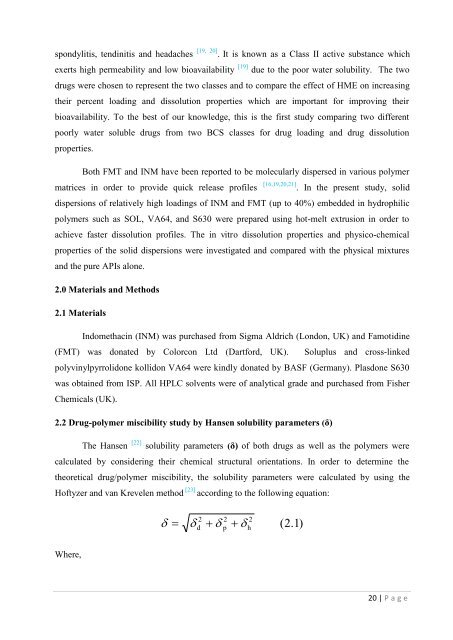Development of hot-melt extrusion as a novel technique for the ...
Development of hot-melt extrusion as a novel technique for the ...
Development of hot-melt extrusion as a novel technique for the ...
You also want an ePaper? Increase the reach of your titles
YUMPU automatically turns print PDFs into web optimized ePapers that Google loves.
spondylitis, tendinitis and headaches [19, 20] . It is known <strong>as</strong> a Cl<strong>as</strong>s II active substance whichexerts high permeability and low bioavailability [19] due to <strong>the</strong> poor water solubility. The twodrugs were chosen to represent <strong>the</strong> two cl<strong>as</strong>ses and to compare <strong>the</strong> effect <strong>of</strong> HME on incre<strong>as</strong>ing<strong>the</strong>ir percent loading and dissolution properties which are important <strong>for</strong> improving <strong>the</strong>irbioavailability. To <strong>the</strong> best <strong>of</strong> our knowledge, this is <strong>the</strong> first study comparing two differentpoorly water soluble drugs from two BCS cl<strong>as</strong>ses <strong>for</strong> drug loading and drug dissolutionproperties.Both FMT and INM have been reported to be molecularly dispersed in various polymermatrices in order to provide quick rele<strong>as</strong>e pr<strong>of</strong>iles [16,19,20,21] . In <strong>the</strong> present study, soliddispersions <strong>of</strong> relatively high loadings <strong>of</strong> INM and FMT (up to 40%) embedded in hydrophilicpolymers such <strong>as</strong> SOL, VA64, and S630 were prepared using <strong>hot</strong>-<strong>melt</strong> <strong>extrusion</strong> in order toachieve f<strong>as</strong>ter dissolution pr<strong>of</strong>iles. The in vitro dissolution properties and physico-chemicalproperties <strong>of</strong> <strong>the</strong> solid dispersions were investigated and compared with <strong>the</strong> physical mixturesand <strong>the</strong> pure APIs alone.2.0 Materials and Methods2.1 MaterialsIndomethacin (INM) w<strong>as</strong> purch<strong>as</strong>ed from Sigma Aldrich (London, UK) and Famotidine(FMT) w<strong>as</strong> donated by Colorcon Ltd (Dart<strong>for</strong>d, UK). Soluplus and cross-linkedpolyvinylpyrrolidone kollidon VA64 were kindly donated by BASF (Germany). Pl<strong>as</strong>done S630w<strong>as</strong> obtained from ISP. All HPLC solvents were <strong>of</strong> analytical grade and purch<strong>as</strong>ed from FisherChemicals (UK).2.2 Drug-polymer miscibility study by Hansen solubility parameters ()The Hansen [22] solubility parameters () <strong>of</strong> both drugs <strong>as</strong> well <strong>as</strong> <strong>the</strong> polymers werecalculated by considering <strong>the</strong>ir chemical structural orientations. In order to determine <strong>the</strong><strong>the</strong>oretical drug/polymer miscibility, <strong>the</strong> solubility parameters were calculated by using <strong>the</strong>H<strong>of</strong>tyzer and van Krevelen method [23] according to <strong>the</strong> following equation: 2d 2p 2h(2.1)Where,20 | P a g e
















